Back To Godhead Vol 52, 1973
|
by Brahmananda Svami
ISKCON East Africa
“My books are more important than myself.” This was Srila Prabhupada’s instruction to one of his disciples who was being sent from his personal service to open a temple in a distant place. When one considers how much time, energy and intelligence Srila Prabhupada has utilized to single-handedly begin and spread the Krsna consciousness movement to an international scale, it is even more astonishing that he has written a score of unique books. Despite his responsibilities in guiding thousands of disciples who operate almost a hundred different centers, that he has produced these books—at substantial sacrifice—proves that the most important factor to the Krsna consciousness movement is the books of His Divine Grace A.C. Bhaktivedanta Swami Prabhupada.
While still in India, His Divine Grace inhabited two ordinary rooms in India’s most historic literary temple. This Radha-Damodara temple was built almost 500 years ago by Srila Jiva Gosvami in the holy site of Vrndavana, where Lord Krsna, the Supreme Personality of Godhead, appeared to display His transcendental pastimes 5,000 years ago. The Radha-Damodara temple, which has since fallen into disrepair, houses the samadhi (burial place) of Jiva Gosvami, one of the six prime disciples of Caitanya Mahaprabhu. Lord Caitanya gave His disciples in Vrndavana three important instructions: first, to discover the exact locations where Krsna displayed His pastimes, as revealed in the sastras (scriptures); then, to build temples where the Lord could be suitably worshiped; and, finally, to write books fully explaining the real science of devotional service to God. Lord Caitanya Himself wrote only eight slokas (stanzas), but the six Gosvamis of Vrndavana have left a vast body of literature for the inestimable benefit of all humanity.
When only ten years old, Jiva Gosvami wanted to join Lord Caitanya’s sankirtana movement, but first he prepared himself by becoming fully versed in Sanskrit in Benares. He was then able to write volumes of books, which have prompted one Indian authority to declare Jiva Gosvami the greatest philosopher that has ever lived. It is lamentable that due to the lack of qualified translators, the English-knowing world may never be able to take advantage of these books.

The Radha-Damodara temple is also the site of the samadhi of Krsnadasa Kaviraja, the most important biographer of Lord Caitanya. Krsnadasa Kaviraja appeared after Lord Caitanya but was contemporary to the six Gosvamis. Directly inspired by Lord Nityananda, one of Lord Caitanya’s principal associates, he wrote his Caitanya-caritamrta at the age of ninety. This book recounts the teachings of Lord Caitanya more vividly than the biographical details which have been preserved by other authors.
The treasure of Radha-Damodara is the samadhi and bhajana) place for executing devotional service) of Srila Rupa Gosvami. Of the six Gosvamis, he is the most important. Rupa Gosvami constructed the largest temple in Vrndavana, Radha-Govindaji, and he wrote the most important book on the science of devotional service, Bhakti-rasamrta-sindhu, which was completed in the year 1552. He and his elder brother Sanatana Gosvami were among the chief government administrators of their time and were highly learned in Arabic, Persian and Sanskrit. Lord Caitanya personally instructed Rupa Gosvami for ten consecutive days, and Bhakti-rasamrta-sindhu codifies these teachings, with supporting evidence from scores of supplementary Vedic texts.

One great acarya (teacher) in the parampara (disciplic succession) has offered obeisances to the six Gosvamis in the following manner: “They are very expert in scrutinizingly studying all the revealed scriptures with the aim of establishing eternal religious principles for the benefit of all human beings. Thus they are honored all over the three worlds, and they are worth taking shelter of because they are absorbed in the mood of the gopis and are engaged in the transcendental loving service of Radha and Krsna.” In one of Srila Prabhupada’s rooms in the Radha-Damodara temple there is a window that overlooks the shaded courtyard where the two tomblike structures that honor Rupa Gosvami stand. Just before this window is a bare wooden asana (seat) where Srila Prabhupada sat to receive inspiration from the greatest of the Gosvamis. From the other room, where he wrote his books, Srila Prabhupada could look out and see Jiva Gosvami’s own worshipable Deities, Radha-Damodara.
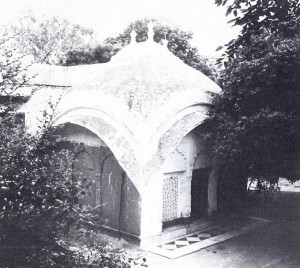
For more than five years Srila Prabhupada lived and worked alone in the Radha-Damodara temple. From the volume of manuscripts and letters he left behind, it is evident that he was constantly writing. He wrote by hand in notebooks, in school lesson pads, and even on the reverse side of mimeographed news releases from the Soviet news agency which was located in nearby Delhi. These releases during the early 1960’s were filled with reports of sputnik achievements, and it was these reports that probably prompted Srila Prabhupada to write the most famous of his shorter books, Easy Journey to Other Planets.
Many of these Radha-Damodara manuscripts are incomplete and as yet unpublished. They include Science of Devotion, Practical Theism, Message of Godhead, Prayers of King Kulasekhara and a lengthy verse to verse translation and purport of the first part of the Caitanya-caritamrta. Also, there is Srila Prabhupada’s voluminous correspondence, addressed to many prominent men in the fields of religion, letters, politics, business and medicine. These letters reveal Srila Prabhupada’s gift for soliciting people to help spread scientific knowledge of God consciousness.
In addition to books and letters, during this time Srila Prabhupada also edited Back to Godhead, a fortnightly paper begun in 1944 in fulfillment of an order by his spiritual master, His Divine Grace Srila Bhaktisiddhanta Sarasvati Gosvami Maharaja. At the very first meeting he had with Srila Prabhupada in 1922, as well as in a letter written only weeks before his demise in 1936, Srila Bhaktisiddhanta Sarasvati specifically requested Srila Prabhupada to propagate the teachings of Krsna consciousness through the medium of the English language. A devotee takes the orders of his spiritual master as his very life, and this is what has impelled His Divine Grace to write prolifically despite many hindrances. Due to spiritual potency, a perfectly executed order received from a higher transcendental authority benefits not only the performer of the duty but also the whole world. Srila Prabhupada’s accomplishment is exactly in the line of the six Gosvamis of Vrndavana. Srila Prabhupada’s books are, to put it quite simply, authorized.
Back to Godhead contained timely articles, essays, book reviews and selections from full-length works in progress such as the Sri Isopanisad. It should be noted that this paper was entirely the effort of Srila Prabhupada. He wrote all the material, edited it, typed it for the printer and checked the galley proofs. Then he sold the copies. Each fortnight he would take batches of Back to Godhead into Delhi. To save a few cents bus fare he sometimes had to walk for miles, and often he would sit in tea parlors until late at night, himself not even taking a glass of water there, preaching and distributing his paper and collecting one cent per copy.
At this time Srila Prabhupada also wrote outlines of his dream. It was a worldwide association of God conscious devotees who actively preached the eternal religion of love of God in all fields of society at large and who used all the modern means at their disposal. The League of Devotees, the forerunner of the now worldwide ISKCON, the International Society for Krishna Consciousness, was thus formally registered. From international sankirtana parties, to gosalas (cow protection reserves), to authorized teaching of Sanskrit, to a printing press solely for flooding the marketplace with Krsna conscious literature, ISKCON is today the reality of that dream.
The most important work Srila Prabhupada wrote while in Vrndavana was his translation, with purports, of the First Canto of the Srimad-Bhagavatam (“The Beautiful Story of the Personality of Godhead”). This work was published by the League of Devotees, but, as with Back to Godhead, it was solely by the effort of Srila Prabhupada. It appeared in three volumes—the first in 1962, the second in 1964, and the third in 1965—all in preparation for the trip to the United States of America which Srila Prabhupada had conceived as the crucial factor in fulfilling his spiritual master’s sacred mission.
Srimad-Bhagavatam is said to be the postgraduate study of Bhagavad-gita. Of course, in the West Bhagavad-gita is well known. Each year finds several new editions on the American market. Every college graduate knows the Gita’s influence on Walt Whitman, Henry David Thoreau and Ralph Waldo Emerson. Albert Einstein also was a regular student of the Gita, and I am told that Robert Oppenheimer, the atomic physicist, quoted a verse from the Eleventh Chapter upon seeing the first test explosion of the atomic bomb in 1945. Yet there have been no English editions of Srimad-Bhagavatam, which is more advanced than Bhagavad-gita.
Bhagavad-gita is spoken by Krsna, the Supreme Personality of Godhead, to His disciple Arjuna, and there unfolds the entire Vedic philosophy of Krsna consciousness. But who is Krsna? A prophet? A philosopher? An incarnation of God? Srimad-Bhagavatam answers this question. Like Bhagavad-gita, it was written 5,000 years ago by Srila Vyasadeva, a literary incarnation of Krsna. In twelve cantos containing 18,000 verses, Srimad-Bhagavatam presents complete information about the Lord, how His energies work, the nature of the living entities or spirit souls, our relationship with God and how to develop love for Him. When one has grasped Srimad-Bhagavatam, then he can fully understand Krsna’s ultimate instruction of Bhagavad-gita: “Just give up everything and surrender unto Me.”
In virtually every one of the hundreds of available editions of Bhagavad-gita, Lord Sri Krsna, the speaker of the Gita, is obscured. Either He is relegated to the position of a historical personage, a mere literary device, or He is conceived as an impersonal ever-existing state of being. This allows the commentator himself to replace Krsna as the speaker of the Gita, and he is then free to present his own interpretations and mental speculations instead of Krsna consciousness.
In the opening sentences of Srila Prabhupada’s introduction to the Srimad-Bhagavatam, he affirms that the word “God” refers to the supreme controller and that a controller cannot be impersonal. In the first sloka of the Srimad-Bhagavatam, obeisances are offered to the Supreme Personality of Godhead.
om namo bhagavate vasudevaya
om—O my Lord; namah—my respectful obeisances unto You; bhagavate—unto the Personality of Godhead; vasudevaya—unto Lord Krsna, the son of Vasudeva.
O my Lord, the all-pervading Personality of Godhead, I offer my respectful obeisances unto You.
Whereas others have translated the Sanskrit scriptures conveniently to suit their interpretations, Srila Prabhupada always gives word-for-word English equivalents for each Sanskrit verse, and thus the translations cannot be disputed. This is a painstaking process, considering the length of the Srimad-Bhagavatam, but it is in keeping with the heritage of the Gosvamis to present the literature of devotional service authoritatively and scientifically. Furthermore, the English-reading public can easily learn the meanings to the Sanskrit words from this format.
Srimad-Bhagavatam is the most mature work of transcendental science written by Srila Vyasadeva. Vyasadeva had compiled the four Vedas and written the Vedanta-sutra, the Puranas and the Mahabharata (which includes Bhagavad-gita), yet he was not satisfied with his work. Therefore his spiritual master, Narada Muni, instructed him to specifically glorify the transcendental activities of Lord Sri Krsna. Thus the famous Tenth Canto of the Bhagavatam reveals the most intimate of Krsna’s pastimes with His devotees. It should be cautioned that there are many professional Bhagavatam reciters who indulge in reading only this most confidential portion of the book, not caring for transcendental realization either for their innocent audiences or for themselves. However, Vyasadeva purposely placed these stories in the later portion of the text so that by reading through the first nine cantos the reader would be spiritually elevated and be able to understand the transcendental nature of these activities. Therefore Srila Prabhupada presents the Bhagavatam in a complete manner, beginning from the very first verse and progressing systematically to the most elevated portion of this great literature.
When Srila Prabhupada finally arrived in America in 1965, he did not come empty-handed. His baggage was a yellow tin box filled with sets of his Bhagavatams. Upon first setting foot on American soil, he wrote a poem addressed to Lord Krsna in Bengali, one passage of which reads as follows: “The words of Srimad-Bhagavatam are Your incarnation, and if people repeatedly hear them in submissive aural reception, then they will be able to understand Your message.”
Srila Prabhupada then commenced his legendary preaching, first in the rural towns of Pennsylvania and then in New York’s Bowery and Greenwich Village. He was practically supporting himself from the sales of his books until ISKCON was incorporated by some interested students and the first center was opened in July, 1966. (Even up until the present, the entire financial growth of the Society depends upon the distribution of Srila Prabhupada’s books by street sales, store distribution, and the Society’s Life Membership program. All major donations and sales proceeds are used for printing books).
On two mimeograph machines personally purchased by Srila Prabhupada, we, his American students, began putting out Back to Godhead, which consisted mostly of Srila Prabhupada’s lectures and some articles and poems by his students. Now that we had started it, we were instructed to publish an issue every month without fail, regardless of our financial situation—even if we could only afford one page. Upon seeing us putting together the first issue, Srila Prabhupada announced that ISKCON Press had been born. In the streets and through shops, we sold as many copies as we were able to run off and staple.
Srila Prabhupada was at that time delivering his lectures three evenings a week and every morning in the storefront assembly hall. One morning he titled his lecture, “Introduction to Bhagavad-gita As It Is by A.C. Bhaktivedanta Swami.” That lecture was transcribed as the present introduction to his book. We learned that Srila Prabhupada was taking rest at 10:00 p.m. and rising at 2:00 a.m. to write his verse by verse translations and purports to the Bhagavad-gita. He would write all morning and then come down and speak on the verses upon which he had commented.
On a portable typewriter given by one of his students, Srila Prabhupada typed out the manuscript page after page. He would spend the remainder of the day writing correspondence, managing the center, speaking to visitors and teaching his students. Despite the threat of immigration difficulties, financial straits and the problems in teaching his fledgling students spiritual life, we watched the manuscript grow day by day. It was a labor of love which continued until one day serious illness struck Srila Prabhupada and he was unable to operate the typewriter. When our shock and confusion cleared away, we managed to purchase a dictaphone, and Srila Prabhupada was able to write by dictating tapes. One day a college student on leave who was an expert typist appeared and offered his services to Srila Prabhupada. Not long afterwards, the manuscript, over one thousand pages, was completed.
Bhagavad-gita As It Is stands as a challenge to all the mental speculators who depart from the Gita’s central teaching of devotional service to the Personality of Godhead, Lord Sri Krsna. Even Mahatma Gandhi stands accused, since his ingenious metaphorical interpretation is simply designed to support his mundane political movement of nonviolence. In India Srila Prabhupada personally requested Gandhi to preach the Gita for what it teaches, Krsna consciousness, just as Srila Bhaktisiddhanta Sarasvati Gosvami Maharaja had personally requested the most famous Indian poet of his time, Rabindranath Tagore.
In the Gita’s Ninth Chapter Lord Krsna categorically advises Arjuna to surrender to Him and to love and worship Him only. He specifically uses the Sanskrit word mam, meaning “unto Me.” Yet one commentator, a renowned Indian philosopher and political leader, begins his commentary on this crucial verse, “It is not to Krsna that we have to surrender…” It is very clear that Krsna and Arjuna are standing on the Battlefield of Kuruksetra and that Krsna is telling Arjuna to surrender unto Him. But this scholar wants to turn the reader away from Krsna by insidiously implying that Krsna actually means to surrender to the eternal unmanifested essence within Himself. But Krsna didn’t say this. Significantly, Srila Prabhupada entitles his comments “purports,” not interpretations. In his purports he gives the actual significance of the verses. Srila Prabhupada informs all deluded scholars that because Krsna is absolute, there is no qualitative difference between His within and His without as there is with conditioned living entities like ourselves.
 Only Srila Prabhupada can title his edition of the Gita “As It Is.” The reason why is readily understood from Krsna’s statement to Arjuna in the beginning of the Fourth Chapter regarding Arjuna’s qualification for receiving the teachings of the Gita. It is not that Arjuna was a great yogi, scholar or ascetic. Krsna said, “You are My devotee and My friend; therefore you can understand this science rightly.” As unusual as it may seem, Srila Prabhupada is virtually the only devotee of Krsna who has commentated on Bhagavad-gita. Krsna also disclosed that the Gita can only be understood by those who are in the line of authorized devotees and acaryas (teachers) known as parampara (disciplic succession). Of the four such successions, the line from Lord Brahma yet remains intact, and Srila Prabhupada is the thirty-second teacher in that line. Vedic knowledge is not unlike a family secret that has been carefully handed down through many generations. Even though the present family descendants were not personally present, they know precisely what took place generations ago.
Only Srila Prabhupada can title his edition of the Gita “As It Is.” The reason why is readily understood from Krsna’s statement to Arjuna in the beginning of the Fourth Chapter regarding Arjuna’s qualification for receiving the teachings of the Gita. It is not that Arjuna was a great yogi, scholar or ascetic. Krsna said, “You are My devotee and My friend; therefore you can understand this science rightly.” As unusual as it may seem, Srila Prabhupada is virtually the only devotee of Krsna who has commentated on Bhagavad-gita. Krsna also disclosed that the Gita can only be understood by those who are in the line of authorized devotees and acaryas (teachers) known as parampara (disciplic succession). Of the four such successions, the line from Lord Brahma yet remains intact, and Srila Prabhupada is the thirty-second teacher in that line. Vedic knowledge is not unlike a family secret that has been carefully handed down through many generations. Even though the present family descendants were not personally present, they know precisely what took place generations ago.
After it was completed, the Gita manuscript was placed in our hands for publication. We approached several big New York publishers, but even with the help of the poet Allen Ginsberg, there was no success. However, Srila Prabhupada had some time previously recorded an album of the hypnotic Hare Krsna mantra, and we happened to receive an order for a copy from an executive at the Macmillan Company. Srila Prabhupada, who was in New York at the time, instructed me to deliver the album personally and inform them that we had books they might be interested to publish. In the executive office, I sat before a man in the accounting section who had nothing to do with publishing books. But then in stepped his colleague, a chief editor. I was introduced, and then I repeated Srila Prabhupada’s offer. Believe it or not, he was just looking to publish an edition of the Gita to fill out their religion section. “Bring in the manuscript tomorrow morning,” he said, “and we’ll publish it.”
The next book, Teachings of Lord Caitanya, was then dictated. It is a summary study of the historic Caitanya-caritamrta. Instead of the exhaustive format of verse to verse translation and purport, Srila Prabhupada presented this book in a shortened but more essential manner. “My books are for my students,” he told us, and so he wanted to write as many as possible. If Bhagavad-gita could be considered the undergraduate study of spiritual life and Srimad-Bhagavatam the master’s study, then Caitanya-caritamrta is the doctorate course. It recounts Lord Caitanya’s teachings to the only five disciples He personally taught. In Teachings of Lord Caitanya, the incomplete philosophy of impersonalism is fully analyzed and forcefully defeated by Lord Caitanya in His discussions with the two biggest impersonalists of His time, Prakasananda Sarasvati and Sarvabhauma Bhattacarya. Also, the quintessence of all detailed knowledge of Krsna and how He acts both in the spiritual and material worlds is disclosed to Ramananda Raya.
The book was published by Prabhupada’s students, who met the costs by donations of all their personal monies. We decided to print it overseas, in Japan, and ultimately in 1968 it came off the presses of one of the world’s largest printing organizations. ISKCON Press was then given full responsibility to publish all of Srila Prabhupada’s books and to develop Back to Godhead to the scale of Time and Life. By this time it was being printed by offset at five thousand copies per month. At Prabhupada’s request, the issues included more articles by his students. He wanted to see how we were realizing what he was teaching, and he was not concerned for outward polish or sophistication in the articles. He said that for a father whose child is first learning how to speak, there is great pleasure even though the child mispronounces the words.
Srila Prabhupada considered Back to Godhead the backbone of the Krsna consciousness movement. He had us give it to a Japanese printer who, to our dismay, could print a minimum of 20,000 copies per issue. “Krsna will distribute them,” Srila Prabhupada assured us. At present, over half a million copies are distributed each month in English, Spanish, French, German, Dutch, Japanese, Hindi, Bengali and Swahili.
Macmillan’s Gita also came out in 1968 in an abbreviated 300 page edition, which included appreciations by several well-known authors for commercial appeal. One author who was very well known for his books on Eastern philosophy and was solicited with a copy of the manuscript for appreciation wrote back a hot letter to Macmillan. He denounced the Bhagavad-gita As It Is by saying that not to interpret the Gita was itself an interpretation. “Our book is successful,” declared Srila Prabhupada. The word juggler had properly understood Bhagavad-gita As It Is and was properly offended.
 In 1969 ISKCON Press composed and printed with its own machinery the Sri Isopanisad, subtitled “The Knowledge that Brings One Nearer to the Supreme Personality of Godhead, Krsna.” It is an elementary book written in verse to verse format and fits as a bridge between the impersonal stress of the Upanisads and the distinct personalism of Bhagavad-gita. Its remarkable introduction, “Teachings of the Vedas,” originally delivered as a lecture in Conway Hall in London, explains how one should best approach a study of the Vedic literature.
In 1969 ISKCON Press composed and printed with its own machinery the Sri Isopanisad, subtitled “The Knowledge that Brings One Nearer to the Supreme Personality of Godhead, Krsna.” It is an elementary book written in verse to verse format and fits as a bridge between the impersonal stress of the Upanisads and the distinct personalism of Bhagavad-gita. Its remarkable introduction, “Teachings of the Vedas,” originally delivered as a lecture in Conway Hall in London, explains how one should best approach a study of the Vedic literature.
Also in 1969, the lawbook for the Krsna consciousness movement was finished. Srila Rupa’s Bhakti-rasamrta-sindhu (“The Ocean of the Nectar of Devotion”) was presented as a summary study entitled The Nectar of Devotion. In the first “wave” of the ocean of nectar, all the Krsna conscious rules, regulations, devotional practices, ceremonies and so on are codified and explained with abundant scriptural evidence. The Nectar of Devotion is greatly responsible for maintaining the spiritual atmosphere and upholding all the devotional discipline in ISKCON’s temples, for it is written in such a way that almost any question in the day to day problems encountered in prosecuting Krsna consciousness can be authoritatively solved. The second “wave” contains incredible details about Lord Sri Krsna, the Supreme Personality of Godhead—His form, personality, abode and pastimes with His devotees. The book concludes with a detailed analysis of the variegated relationships of devotion that the living entities have with God, or Lord Krsna. The Nectar of Devotion was printed entirely by ISKCON Press. When the first copy was presented to Srila Prabhupada, he requested that we read aloud from it. When asked which portion he would like to hear, he replied, “Read from any part you open. Sugar tasted on any side is sweet.”
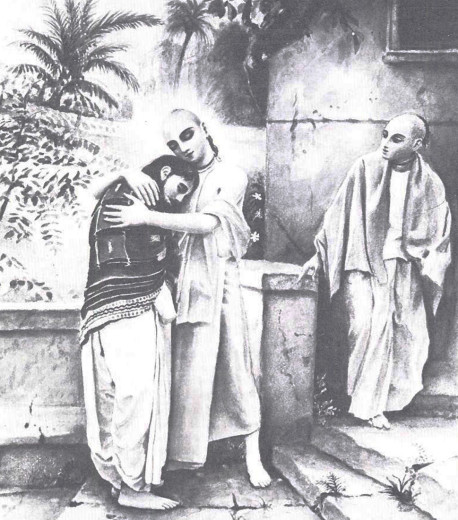
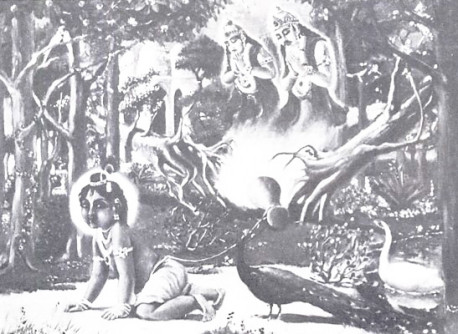
One day when several of Srila Prabhupada’s leading disciples were assembled before him, he announced that he had been requested to write a summary study of the Tenth Canto of the Srimad-Bhagavatam. If Srila Prabhupada proceeded translating canto by canto, some students feared, he might not be able to complete the confidential Tenth Canto in his life time. Because this portion had been so misrepresented by materialistic religionists, he wanted to leave behind an edition which presented this important portion in its proper transcendental perspective. He took our approval and then began dictating Krsna, the Supreme Personality of Godhead. This work is the most entertaining of all of Srila Prabhupada’s books. He conceeded that he was writing it in such a way that the reader would not detect the philosophy. In the Bhagavatam, Sukadeva Gosvami, its principal reciter, has declared that there are three classes of men who will be attracted to Krsna’s pastimes. Those very advanced in transcendental realization, the liberated souls, will relish the pastimes. Those who are on the path to achievement of liberation will automatically be purified, and even the gross materialist will enjoy them because of the resemblance between Krsna’s affairs with the gopis and the love affairs between ordinary men and women.
The book was printed in Japan in 1970 in two volumes of 750 pages, with the addition of 82 full-color plates. Several talented disciples had labored for almost six months to produce magnificent paintings depicting the pastimes. Virtually every detail was referred for Srila Prabhupada’s approval because the paintings also had to be “as it is.” A welcome introduction by musician George Harrison, who contributed the entire cost of printing the first volume, completes the set of books. Although more expensive than all other of Srila Prabhupada’s books, the Krsna Books are the most popular, having gone into three printings to date, as well as publication in a three-volume paperback edition.
Srila Prabhupada had never been entirely satisfied with Macmillan’s edition of his Gita because they had drastically shortened it for business reasons. However, when the book was well into its fifth printing, Macmillan informed him that they would be honored to bring out the complete edition, including the Sanskrit slokas. All other published editions of the Gita were decreasing in sales, they reported, whereas Srila Prabhupada’s was steadily increasing. Therefore, in the fall of 1972, the Macmillan Company released the complete edition of Bhagavad-gita As It Is, containing the entire text of Srila Prabhupada’s original manuscript, fully indexed and cross-referenced, along with more than fifty color plates. Finally, this was indeed the complete and authoritative edition of Bhagavad-gita that we had hoped for. The paintings dramatically portray the ideas of the Gita’s verses and Srila Prabhupada’s purports. Simply from the pictures the reader will be able to understand the great transcendental message of Bhagavad-gita.
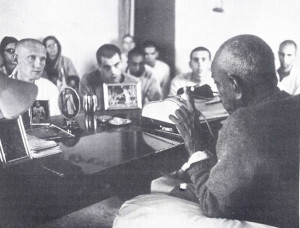 Soon to be released from Japan are eight fully illustrated volumes comprising the first three cantos of the Srimad-Bhagavatam in verse to verse format. The Fourth Canto is still in the manuscript stage. Also still in manuscript is a large two-volume work in which Srila Prabhupada discusses the ideas of major ancient and contemporary philosophers—from Aristotle and Plato to Jean-Paul Sartre and modern theoretical physicists—in the light of Krsna consciousness.
Soon to be released from Japan are eight fully illustrated volumes comprising the first three cantos of the Srimad-Bhagavatam in verse to verse format. The Fourth Canto is still in the manuscript stage. Also still in manuscript is a large two-volume work in which Srila Prabhupada discusses the ideas of major ancient and contemporary philosophers—from Aristotle and Plato to Jean-Paul Sartre and modern theoretical physicists—in the light of Krsna consciousness.
We do not know what Srila Prabhupada’s literary program will be for the future. Since his last books, he has been extensively traveling and preaching, especially throughout lndia and Africa. He is now in Japan on his way back to the United States on his fifth tour around the world since 1965. It is the hope of his disciples that while in the USA he will be able to retire from active management of ISKCON to completely devote himself to his writing, which he has wanted to do for a long time. There are eight cantos of Srimad-Bhagavatam remaining, as well as the manuscripts started in Vrndavana and one incomplete manuscript of the Vedanta-sutra.
Srila Prabhupada, as a pure devotee free from all defects, can transmit the Absolute Truth as it has been carefully set down in the Vedic literature, like a mailman who delivers a letter without opening it to add or subtract something. Because Srila Prabhupada is qualified to receive the king of all education, he is empowered to pass it on purely. His books are considered Vedic literature because they are in pursuance of Vyasadeva’s original intentions. Thus Srila Prabhupada’s translations and purports are nondifferent from the original instructions delivered 5,000 years ago by Lord Krsna.
The mission of Lord Caitanya to defeat impersonalism and establish the Personality of Godhead, Lord Krsna, as the supreme has fully fructified for the benefit of the modern world in the books of His Divine Grace A.C. Bhaktivedanta Swami Prabhupada. The Nectar of Devotion figuratively states that impersonalists dwell in the rivers of liberation which gradually lead down to the ocean of nectar to merge with it. They do not know that devotees are in a better position. Devotees don’t care at all for the rivers of liberation, for they are like sharks who dwell eternally in the deep ocean of transcendental loving service.
Not having fully realized God, the impersonalist concludes that He is formless, nameless, without personality or abode, and does not engage in activities. Then, who is God? To say He is not this, not this, and not that means that He is nothing—which is to say that there is no God. Thus, impersonalism has given great impetus to the atheism which characterizes modern civilization. God cannot be formless, because if He were less than anything in His creation, how could He be the complete whole? God, the complete whole, must have everything within and beyond our experience.
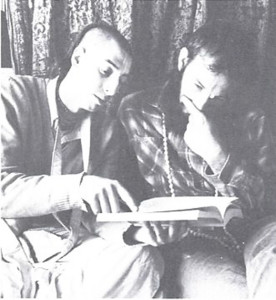 From the statements of virtually every Vedic source, Krsna is accepted as Bhagavan, the Supreme Personality of Godhead. As Bhagavan, “possessor of opulences,” Krsna exhibits all beauty, all fame, all wealth, all knowledge, all strength and all renunciation. Since the very word “Krsna” means “all-attractive,” Srila Prabhupada explicitly explains all of God’s all-attractive features. Whereas the scriptures of other religions terminate with the conclusion that God is great, Srila Prabhupada begins from that realization to explain how He is great. The science of the Absolute Truth transcends sectarian religious principles. One who reads Srila Prabhupada’s books will know God perfectly, regardless of sectarian conceptions of God to which he may adhere. No other literature in philosophy, religion or yoga is as complete as the body of work that Srila Prabhupada has dutifully presented to the English-speaking world. This is due to the perfection of the main theme in Srila Prabhupada’s books—devotional service—which far exceeds the four perfections of material life: sense gratification, economic development, pious activities and liberation. The superb quality of Srila Prabhupada’s books is due simply to his glorifying the Supreme and presenting Him as He is.
From the statements of virtually every Vedic source, Krsna is accepted as Bhagavan, the Supreme Personality of Godhead. As Bhagavan, “possessor of opulences,” Krsna exhibits all beauty, all fame, all wealth, all knowledge, all strength and all renunciation. Since the very word “Krsna” means “all-attractive,” Srila Prabhupada explicitly explains all of God’s all-attractive features. Whereas the scriptures of other religions terminate with the conclusion that God is great, Srila Prabhupada begins from that realization to explain how He is great. The science of the Absolute Truth transcends sectarian religious principles. One who reads Srila Prabhupada’s books will know God perfectly, regardless of sectarian conceptions of God to which he may adhere. No other literature in philosophy, religion or yoga is as complete as the body of work that Srila Prabhupada has dutifully presented to the English-speaking world. This is due to the perfection of the main theme in Srila Prabhupada’s books—devotional service—which far exceeds the four perfections of material life: sense gratification, economic development, pious activities and liberation. The superb quality of Srila Prabhupada’s books is due simply to his glorifying the Supreme and presenting Him as He is.
Although the sales figures for Srila Prabhupada’s books approach those of consistent best sellers due to the vigorous efforts of ISKCON, critics have mainly ignored them. There does not seem to be any solution to this problem due to the lack of critics who are qualified to understand and explicate transcendental knowledge. The Macmillan Gita received only a handful of reviews, with the nation’s largest reviewing syndicate criticizing Srila Prabhupada for treating Bhagavad-gita as the literal word of God.
Be that as it may, the lives of several thousand young men and women from all over the world have been dramatically changed either by their coming into personal contact with Srila Prabhupada or simply by their reading his books. There is an instance of one boy who was stationed in the US Air Force in Spain. He was so impressed by Bhagavad-gita As It Is that he immediately took leave to visit the ISKCON center in London. Soon afterward, upon his military discharge, he surrendered himself as a disciple and servant. In accordance with the teachings of Krsna in Bhagavad-gita, Srila Prabhupada teaches the technique for practicing real spiritual life. He does not give only theoretical knowledge. In Bhagavad-gita Krsna first imparts to Arjuna knowledge of what is material and what is spiritual and who he is, but ultimately He instructs Arjuna to fight on the battlefield. Although this has been variously interpreted by commentators, the true significance of this is that in order to realize the spiritual instructions given to him by Krsna, his guru, Arjuna had to render devotional service without material attachment and thus satisfy Krsna. Thus the message of the Gita is to surrender oneself to God.
It should be noted that all of Srila Prabhupada’s disciples, many of whom are college graduates and former teachers, social workers, etc., find that they have ceased reading other books after reading those by Srila Prabhupada. This is perhaps best explained by the preface to Krsna, the Supreme Personality of Godhead, where Srila Prabhupada says that people love to read various kinds of fiction, but now, with this book, this tendency can be directed toward Krsna, or God. “The result will be the imperishable satisfaction of the soul, both individually and collectively. … One will find that by reading one page after another, an immense treasure of knowledge in art, science, literature, philosophy and religion will be revealed, and ultimately by reading this one book, Krsna, love of Godhead will fructify.”
Srila Prabhupada teaches the most difficult and sublime science—the science of how to serve God—in such a way that anyone can understand it. The concepts are presented over and over again, for repetition is a time-tested learning technique in transcendental study. Thus in whichever of Srila Prabhupada’s books one reads first, one will find the entire science of Krsna consciousness presented, yet each succeeding book reveals something more, and with each rereading one will find new light. Srila Prabhupada’s books are the most wonderful vehicle because they swiftly transport the reader to a timeless and ever- green world where everyone is joyfully awakened to the Absolute Truth of Krsna, the Supreme Personality of Godhead.


Leave a Reply